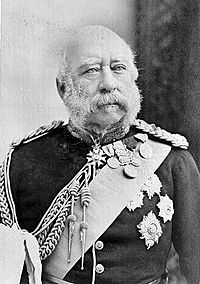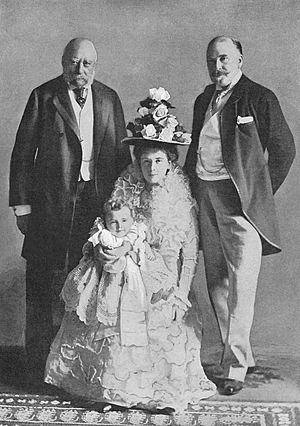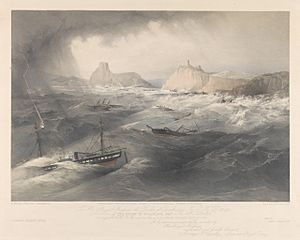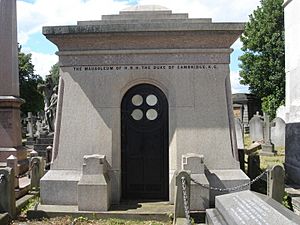Prince George, Duke of Cambridge facts for kids
Quick facts for kids Prince George |
|||||
|---|---|---|---|---|---|
| Duke of Cambridge | |||||

The Duke of Cambridge, c. 1900
|
|||||
| Born | Prince George of Cambridge 26 March 1819 Cambridge House, Hanover |
||||
| Died | 17 March 1904 (aged 84) Gloucester House, Piccadilly |
||||
| Burial | 22 March 1904 Kensal Green Cemetery, London |
||||
| Spouse |
Sarah Fairbrother
(m. 1847; died 1890) |
||||
| Issue | George FitzGeorge Adolphus FitzGeorge Augustus FitzGeorge |
||||
|
|||||
| House | Hanover | ||||
| Father | Prince Adolphus, Duke of Cambridge | ||||
| Mother | Princess Augusta of Hesse-Kassel | ||||
| Signature |  |
||||
| Military career | |||||
| Allegiance | United Kingdom | ||||
| Service/ |
British Army | ||||
| Rank | Field marshal | ||||
| Commands held | Commander-in-Chief of the Forces | ||||
Prince George, Duke of Cambridge (born George William Frederick Charles; 26 March 1819 – 17 March 1904) was a member of the British royal family. He was a grandson of King George III and a cousin of Queen Victoria. Prince George was a professional army officer. He served as the military head of the British Army, known as Commander-in-Chief of the Forces, from 1856 to 1895. He became the Duke of Cambridge in 1850 and a field marshal in 1862.
Contents
Early Life of Prince George
Prince George was born at Cambridge House in London. His father was Prince Adolphus, Duke of Cambridge. He was the seventh son of King George III and Queen Charlotte. His mother was Princess Augusta of Hesse-Kassel.
He was baptized at Cambridge House on 11 May 1819. His godparents included the Prince Regent (who later became King George IV).
Prince George's Military Career
Prince George of Cambridge grew up and was educated in Hanover and England. Like his father, he chose a career in the military. He first became a colonel in the Hanoverian Army. Then, in 1837, he became a colonel in the British Army.
He worked in Gibraltar and Ireland. In 1842, he became a lieutenant-colonel in the 8th Light Dragoons. He also became a colonel of the 17th Lancers.
From 1843 to 1845, he served as a colonel in the Ionian Islands. He was promoted to Major-General in 1845. When his father passed away in 1850, George inherited his titles. He became the Duke of Cambridge, Earl of Tipperary, and Baron Culloden.
In 1852, the Duke of Cambridge became the Inspector of the Cavalry. In February 1854, he took command of the 1st Division of the British army. This was during the early part of the Crimean War (1853–1856). He was promoted to lieutenant-general in June 1854.

He was present at important battles during the Crimean War. These included the Alma (September 1854), Balaclava (October 1854), and Inkerman (November 1854). He also took part in the Siege of Sevastopol (1854–1855).
After the Crimean War ended in March 1856, the Duke was given a very important role. On 5 July 1856, he became the general commanding-in-chief of the British Army. This role was later renamed commander-in-chief of the forces. He held this position for a long time. He was promoted to general in 1856 and field marshal in 1862. In this role, he advised the Secretary of State for War. He was also in charge of the army's management and its forces in the field.
Duke George's Army Policies
The Duke of Cambridge was commander-in-chief for 39 years. He encouraged the army to try out new types of breech-loading guns for the cavalry. One of these, the Westley Richards, worked so well that they considered making it for infantry soldiers too.
He also helped create the Staff College and the Royal Military School of Music. He became governor of the Royal Military Academy, Woolwich. He wanted to make the army better by having annual military training exercises. In 1860, he changed the rules for corporal punishment (physical punishment). Soldiers could only be flogged for very serious actions during wartime.
Prince George's Views on Army Reforms
Many people felt that the British Army became slow and old-fashioned under the Duke's leadership. He was known for not liking new ideas. He once said, "There is a time for everything, and the time for change is when you can no longer help it."
After the Prussian army won the Franco-Prussian War in 1870–71, the British government wanted to make big changes to the army. The Prime Minister, William Ewart Gladstone, and the Secretary of State for War, Edward Cardwell, pushed for these changes. Cardwell made several reforms. One reform made the commander-in-chief officially report to the Secretary of State for War.
The Duke opposed most of these reforms. He believed they would harm the army he knew. He worried that new reservists (soldiers who are not full-time but can be called up) would not be useful in conflicts far away. He also thought that sending troops overseas would take the best soldiers from home-based units.
In 1871, Cardwell ended the practice of officers buying their positions in the army. This had created an elite group of officers. The Duke strongly disliked this change. Many officers also disagreed because they could no longer sell their positions when they retired.
As the Duke of Cambridge got older, more people wanted reforms. His cousin, Queen Victoria, was his strongest supporter. While the Queen wanted some changes, she also protected the traditions of the army. A royal commission in 1890 suggested that the War Office needed better management. It also recommended giving more power to other military officers.
Many reformers wanted the Duke to be replaced. These included Henry Campbell-Bannerman and Lord Lansdowne. The Duke of Cambridge was forced to resign from his post on 1 November 1895. Lord Wolseley took over his role. After he resigned, he was given the honorary title of colonel-in-chief to the Forces.
Some historians believe that the Duke's resistance to change led to problems for the British Army. These problems became clear during the Second Boer War (1899–1902). The army was criticized for its lack of organization and officers who were not well-trained.
Marriage and Family Life
It was once hoped that Prince George would marry his cousin, Queen Victoria. However, Victoria's uncle arranged for her to marry Prince Albert of Saxe-Coburg and Gotha.
The Duke of Cambridge believed that "arranged marriages were doomed to failure." He married privately on 8 January 1847 to Sarah Fairbrother (1816 – 12 January 1890). Sarah was an actress. Their marriage was against the 1772 Royal Marriages Act. Because of this, Sarah was not called Duchess of Cambridge. Their sons born after the marriage could not inherit the Duke's titles. Sarah called herself "Mrs. Fairbrother" and later "Mrs. FitzGeorge."

The Duke of Cambridge and Mrs. FitzGeorge had three sons. All of them had military careers.
| Name | Birth | Death | Notes |
|---|---|---|---|
| George FitzGeorge | 24 August 1843 | 2 September 1907 | married Rosa Baring; they had children. |
| Adolphus FitzGeorge | 30 January 1846 | 17 December 1922 | married (1) Sofia Holden; had children (Olga FitzGeorge); (2) Margaret Watson; no children. |
| Augustus FitzGeorge | 12 June 1847 | 30 October 1933 | Colonel Sir Augustus FitzGeorge, KCVO, CB; no marriage or children. |
Later Life and Legacy
In his later years, the Duke's health declined. He passed away from a stomach hemorrhage in 1904 at Gloucester House in London. He was buried five days later next to his wife at Kensal Green Cemetery, London.
Today, the Duke is remembered by an equestrian statue (a statue of him on horseback) in Whitehall, central London. It stands outside the War Office building. He is also remembered by street names in southwest London, George Road and Cambridge Road. He inherited much of the land in that area from his father.
Titles, Styles, and Honours
Titles and Styles
- 26 March 1819 – 8 July 1850: His Royal Highness Prince George of Cambridge
- 8 July 1850 – 17 March 1904: His Royal Highness The Duke of Cambridge
Prince George also held the titles of 'Prince of Hanover' and 'Duke of Brunswick and Lüneburg'.
When he died, his title, 'Duke of Cambridge', ended. It was not used again for 107 years. In 2011, Elizabeth II gave the title to her grandson, Prince William, on his wedding day.
Honours
- British
- KG: Royal Knight of the Most Noble Order of the Garter, 15 August 1835
- KP: Extra Knight of the Most Illustrious Order of St Patrick, 17 November 1851
- Hon DCL: Doctor of Civil Law, Oxford University, 1853
- GCB: Knight Grand Cross of the Most Honourable Order of the Bath (military division), 5 July 1855
- PC: Privy Counsellor of Great Britain, 1856
- Hon LLD: Doctor of Laws, Cambridge University, 1864
- PC (I): Privy Counsellor of Ireland, 21 April 1868
- Hon LLD: Doctor of Laws, Dublin University, 1868
- GCMG: Grand Master and Principal Knight Grand Cross of the Most Distinguished Order of St Michael and St George, 30 May 1877
- GCSI: Extra Knight Grand Commander of the Most Exalted Order of the Star of India, 2 June 1877
- KT: Extra Knight of the Most Ancient and Most Noble Order of the Thistle, 17 September 1881
- GCIE: Extra Knight Grand Commander of the Most Eminent Order of the Indian Empire, 21 June 1887
- VD: Volunteer Decoration
- ADC: Personal Aide-de-Camp to the Sovereign, 1 November 1895
- KJStJ: Knight of Justice of the Most Venerable Order of the Hospital of St John of Jerusalem, 1896
- GCVO: Knight Grand Cross of the Royal Victorian Order, 30 June 1897
- Foreign
- Grand Cross of the Royal Hanoverian Guelphic Order, 1825 (Hanover)
- Grand Cross of the Order of Henry the Lion, 1835 (Brunswick)
- Knight of the Order of St George, 1839 (Hanover)
- Grand Cross of the Royal Order of the Legion of Honour, September 1843 (France)
- Grand Cross of the House Order of the Golden Lion, 18 December 1844 (Hesse-Kassel)
- Knight of the Order of the Black Eagle, 7 September 1852 (Prussia)
- Knight of the House Order of Fidelity, 1856 (Baden)
- Grand Cross of the Order of the Zähringer Lion, 1856 (Baden)
- Grand Cross of the Royal Hungarian Order of St Stephen, 1857 (Austria)
- Knight of the Order of the Gold Lion of the House of Nassau, September 1859 (Nassau)
- Grand Cross of the House Order of the Wendish Crown, with Crown in Ore, 13 August 1865 (Mecklenburg)
- Grand Cross of the Royal Military Order of the Tower and Sword, 8 January 1866 (Portugal)
- Knight of the Order of the Elephant, 26 March 1867 (Denmark)
- Knight of the Order of St Andrew the Apostle the First-called, 1874 (Russia)
- Grand Commander's Cross of the Royal House Order of Hohenzollern, 23 September 1880 (Prussia)




